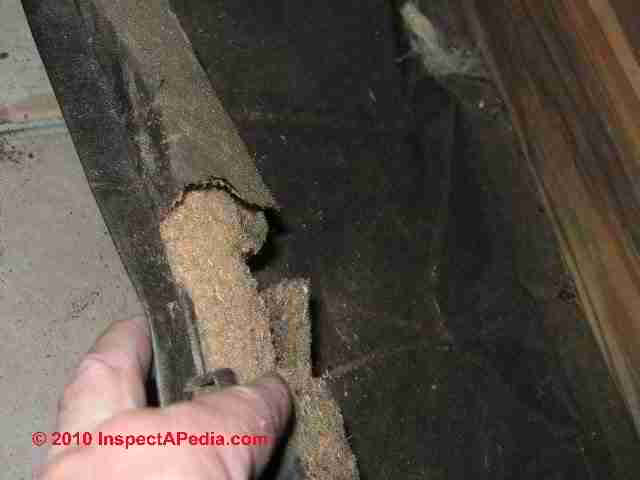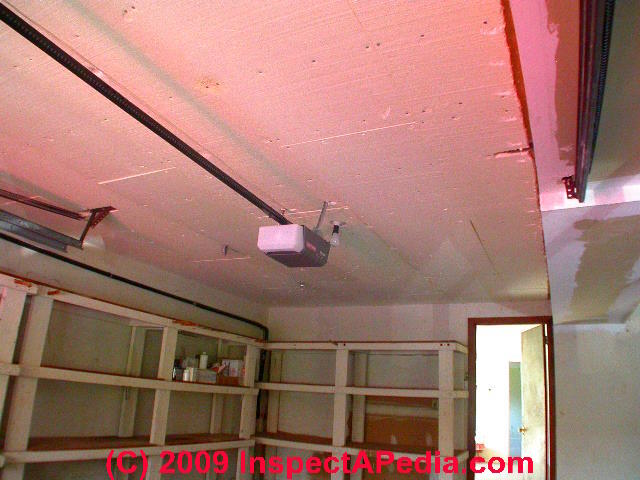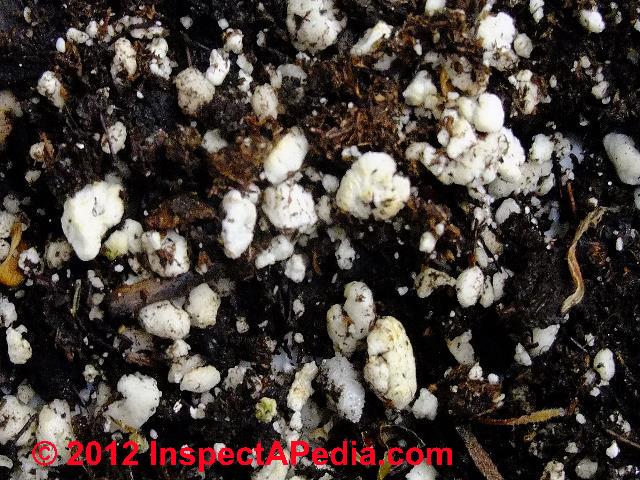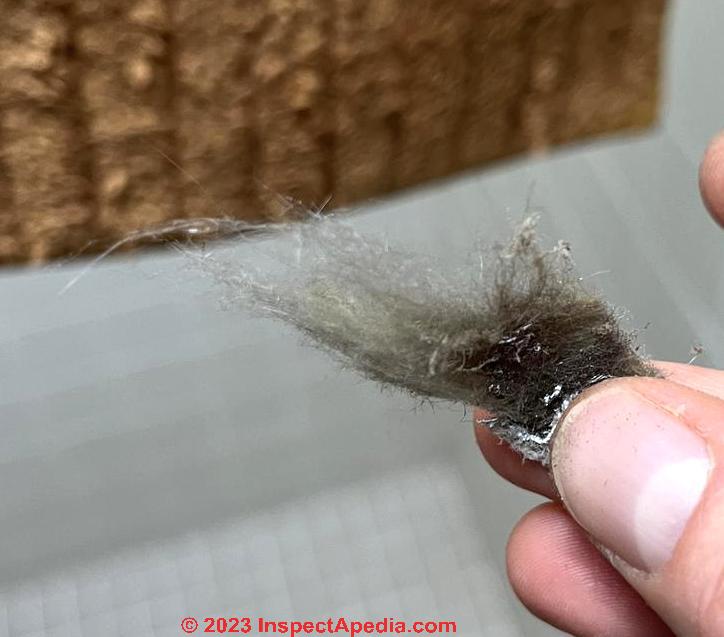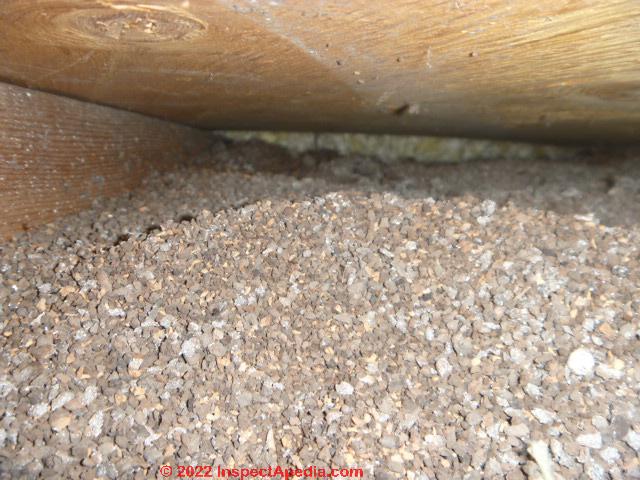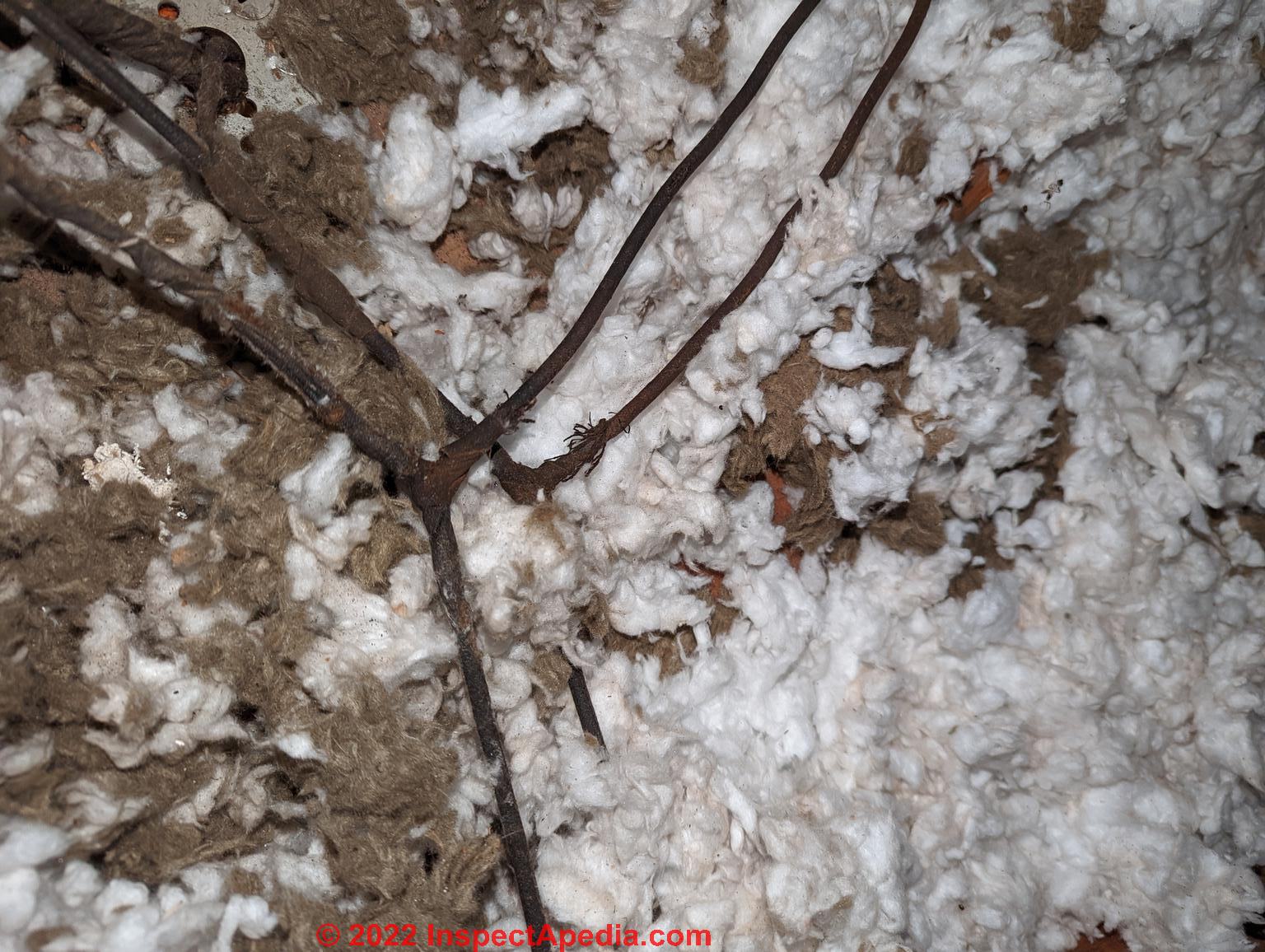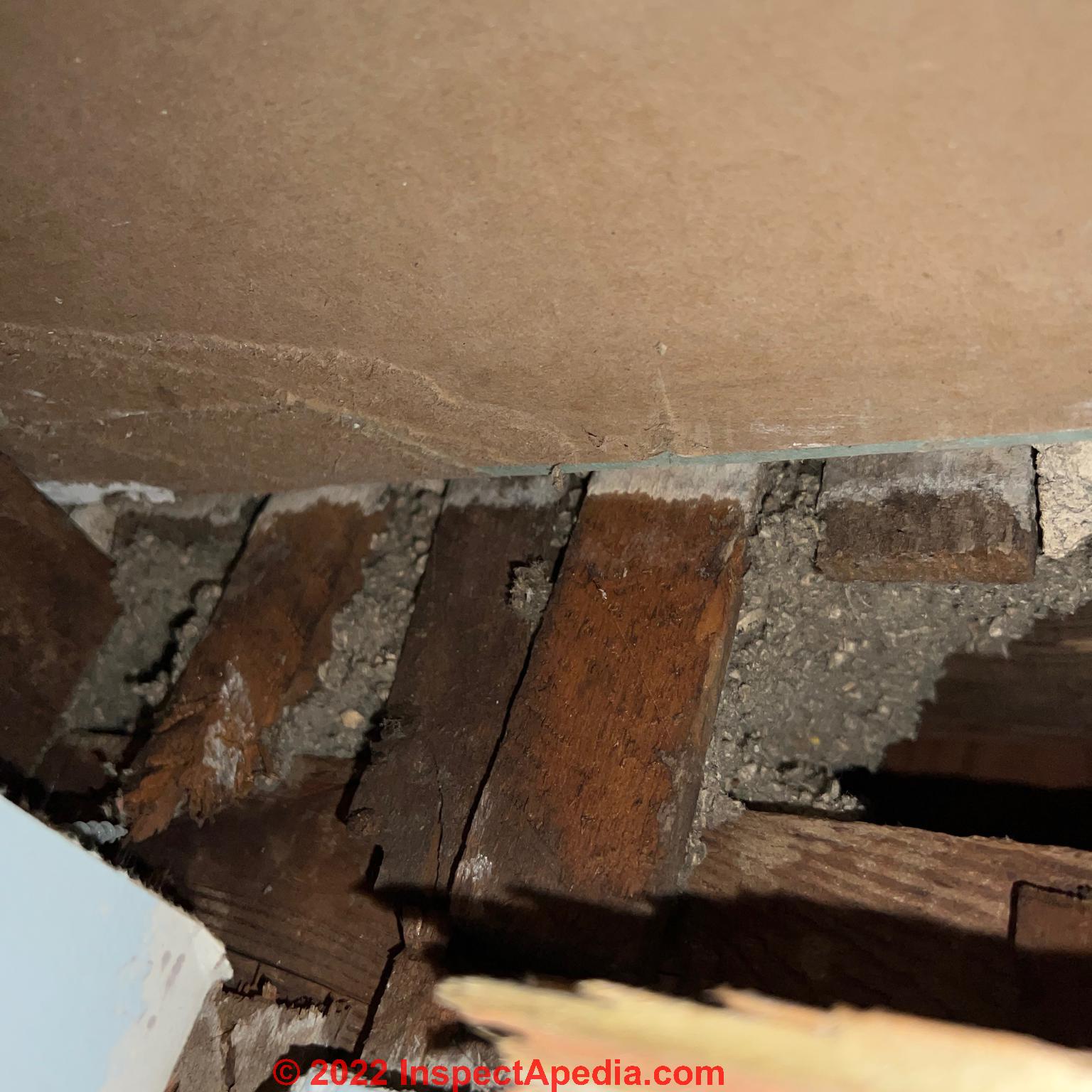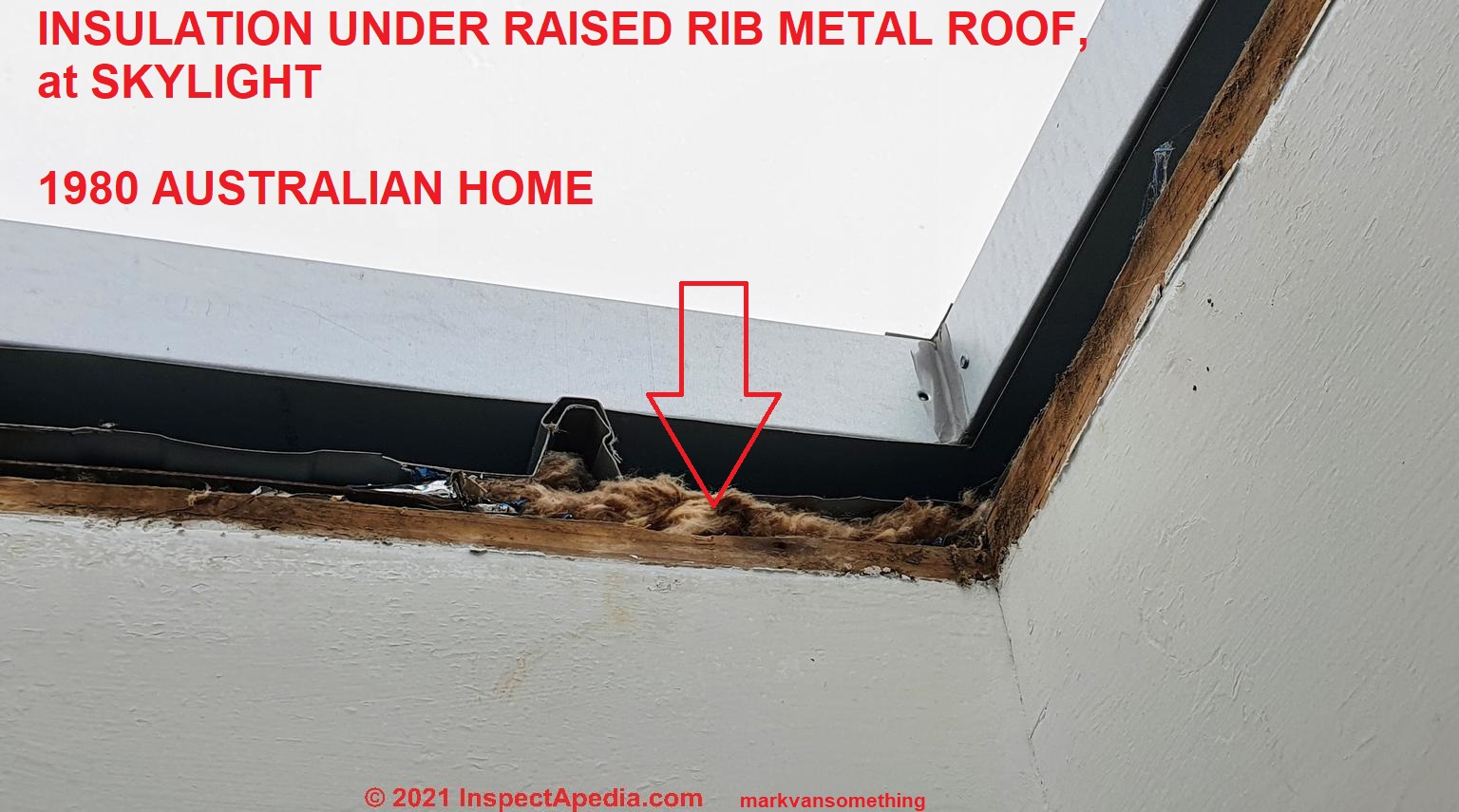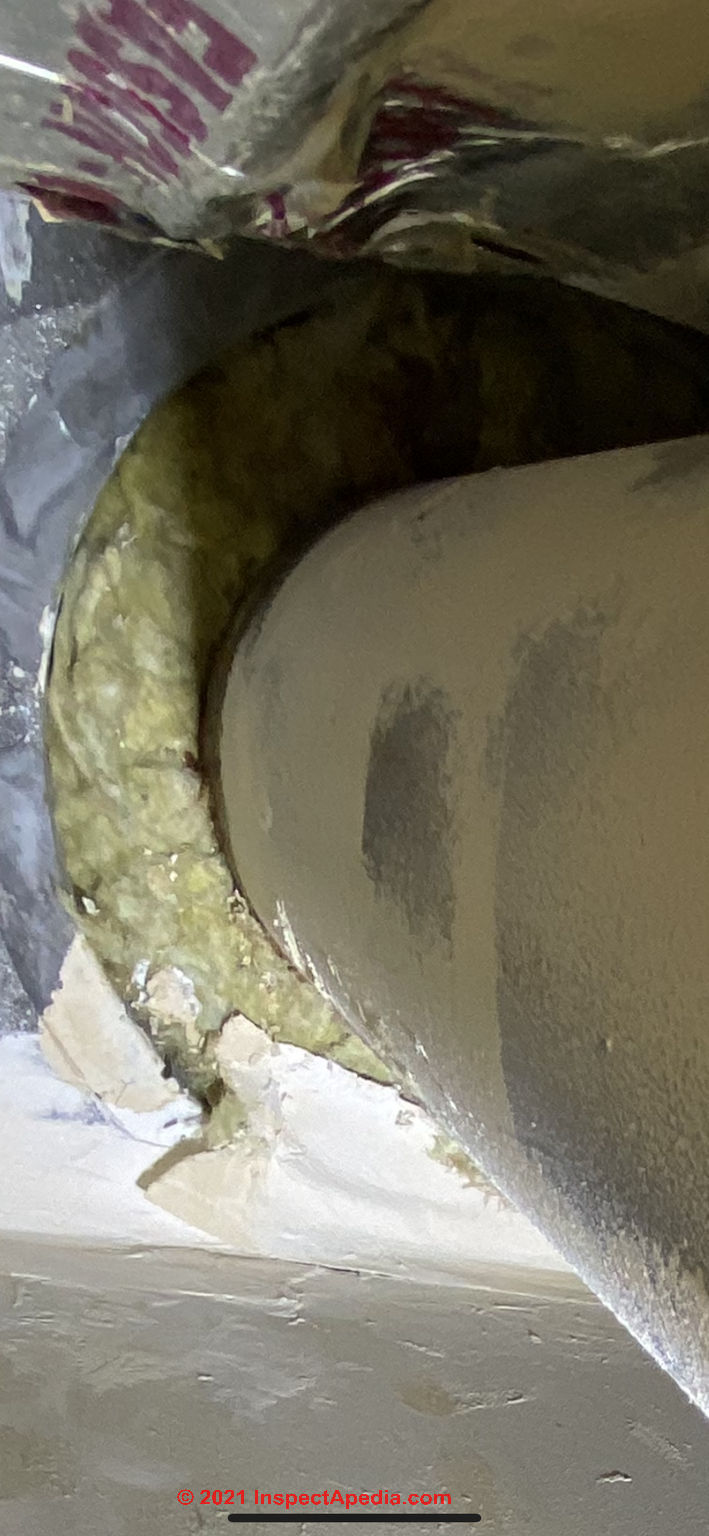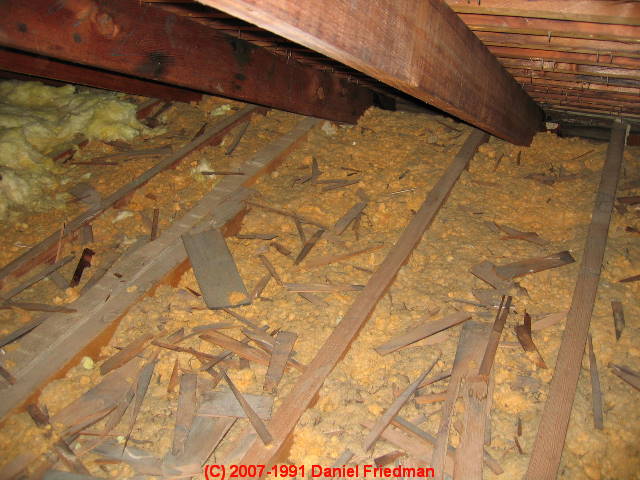 Building Insulation Guide
Building Insulation Guide
Home Page & Index to Articles
- POST a QUESTION or COMMENT about identifying & troubleshooting building insulation & ventilation systems
This page provides our index to articles on building insulation selection, installation, inspection, troubleshooting, & improvement or repair.
This article series discusses how to inspect, diagnose and correct problems in building insulation or ventilation systems.
We discuss Insulation R-values, Types, & other characteristics, Insulation types, R-values, installation, improvements, troubleshooting insulation & heat loss or unwanted heat gain problems.
We also describe how to install or repair building insulation & ventilation systems including using stains and other clues to diagnose air movement, heat loss or moisture problems.
Page top photo: chopped fiberglass insulation in an older home, covered with debris from a wood shingle roof replacement job.
InspectAPedia tolerates no conflicts of interest. We have no relationship with advertisers, products, or services discussed at this website.
- Daniel Friedman, Publisher/Editor/Author - See WHO ARE WE?
Guide to Inspection of Building Insulation & Ventilation
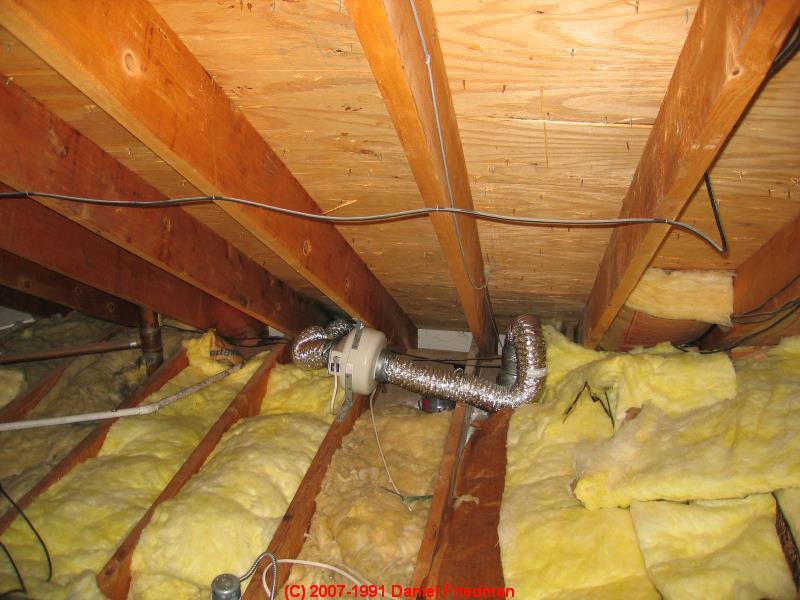 The articles listed here provide in-depth discussions of how to identify various types of insulation and building ventilation systems, including where insulation or ventilation defects occur and what is their effect on buildings.
The articles listed here provide in-depth discussions of how to identify various types of insulation and building ventilation systems, including where insulation or ventilation defects occur and what is their effect on buildings.
We also discuss various indoor air quality issues involving building insulation such as asbestos and fiberglass particle contamination, mold in insulation, and building moisture and condensation where insulation and ventilation have not been properly installed.
Insulation products are used in a very wide range of building products and building locations besides attic, ceiling, and wall insulation.
Some kinds of insulation can be tricky to identify and may have special concerns which are discussed in these articles.
Photo just above: two generations of fiberglass batt insulation in this attic, batts piled sloppily at right side, a possible indication of amateur work, and also a poorly-installed bath exhaust fan duct with too many sharp bends.
To find what you need quickly, if you don't want to scroll through this index you are welcome to use the page top or bottom SEARCH BOX to search InspectApedia for specific articles and information.
- ACOUSTICAL SEALANT CHOICES - use of sealants or tapes to seal polyethylene vapor barrier lap joints
- AIR BYPASS LEAKS - how dark stains on building walls, ceilings, and insulation can show up thermal bypass leaks and heat loss
- AIR LEAK DETECTION TOOLS - how to find and fix air and heat leaks on buildings, an expert guide to weatherization
- AIR LEAK MINIMIZATION - how to retrofit a building to tighten a leaky house
- AIR SEALING STRATEGIES - different strategies for sealing a leaky building to save energy
- ASBESTOS PIPE INSULATION in BUILDINGS - how to identify asbestos pipe insulation, how to inspect and report its condition
- ATTIC CONDENSATION CAUSE & CURE - a complete guide to
- ATTIC INSULATION MISSING- Expert home inspector Roger Hankey uses outdoor clues to find a home at which the insulators forgot to insulate
- BALSAM WOOL BATT INSULATION- properties - Blackweld wool fiber/cellulose insulation is shown in the kraft facing tear in the photo just above.
- BASEMENT HEAT LOSS - where and how to insulate basements and foundation walls
- BASEMENT MOLD includes examples of moldy fiberglass insulation found in basements
- BLOCKED SOFFIT INTAKE VENTS - cause of building moisture problems, ice dams, leaks
- BLOWER DOORS & AIR INFILTRATION - how to measure air leaks, equivalent leakage area (ELA), and air changes per hour (ACH) in a building
- BLOWER FAN OPERATION & TESTING
- BLOWN-IN INSULATION
- BRICK or BLOCK WALL CAVITY INSULATION and BRICK VENEER WALL AIR LEAKS - insulating masonry building walls and masonry veneer walls
- BRICK LINED WALLS - Brick "Insulation" in Building Walls how inspect, report, and repair brick nogging, or solid brick "insulation" in antique building walls
- BRICK VENEER WALL AIR LEAKS
- BUCKLED FOUNDATIONS due to INSULATION? - does insulating the foundation lead to frost damage or collapse?
- CASEWORK, CABINETS, SHELVING INSTALLATION - how to prevent cold kitchen cabinets and cold dishes
- CATHEDRAL CEILING INSULATION - how to properly insulate and ventilate cathedral ceilings and enclosed roof cavities
- CATHEDRAL CEILING VENTILATION - where and how to get venting working in a cathedral ceiling
- CELLULOSE LOOSE-FILL INSULATION- cellulose blown-in insulation or loose-fill properties, mold resistance, moisture properties, odors, R-values
- CERAMIC INSULATION - properties
- CONCRETE INSULATION, LIGHT-WEIGHT- properties
- CONVECTIVE LOOPS & THERMAL BYPASS LEAKS- how air movement in interior partitions steals heat from buildings
- COTTON INSLULATING BATTS - properties, brands, identification
- CRAWLSPACE MOLD includes additional examples of moldy fiberglass insulation found in crawl spaces
- ENERGY SAVINGS in BUILDINGS - complete list of building energy savings articles
- ENERGY SAVINGS RETROFIT OPTIONS includes ultra lightweight concrete insulation, insulating forms for concrete foundations
- FIBERGLASS INSULATION IDENTIFICATION & PROPERTIES - fiberglass insulation properties, identification, binder resins, mold contamination, R-values, the works.
- FIRE PROTECTION FOR FOAM BOARD INSULATION - the importance of covering exposed foam insulation products used indoors.
Shown just below is pink foam board insulation on a building ceiling. Leaving this insulation exposed in an occupied building space is a fire hazard and usually a building code violation.
- FOAM BOARD INSULATION TYPES - properties.
- FOAM INSLUATION SPRAY PRODUCT Guide: If you are having trouble determining what type of foam insulation product has been installed in a building,
see HOW TO IDENTIFY UFFI, ICYNENE, and LATEX FOAM INSULATION for detailed on the identification of these products in the field. - FOUNDATION INSULATION OPTIONS - where, how, how much insulation to put inside or outside foundation walls
- FRAMING DETAILS for BETTER INSULATION - avoid cold spots, air leaks
- GREENHOUSE or SOLARIUM - insulation for
- HEAT LOSS RATE CALCULATIONS - R, U, & K VALUES, Insulation Properties, Definitions of R, K, U values, Insulation Design
- HEATING COST SAVINGS METHODS - set priorities for savings on heating costs
- HOMASOTE & OTHER INSULATING BOARD PRODUCTS - identification, properties, asbestos content
- HOT ROOF DESIGN PROBLEMS - evaluation of unvented roof designs, durability, risks
- HOUSE DOCTOR, how-to be - where to get tools, test equipment, training to find heat loss & air leaks in buildings
- HOUSEWRAP AIR & VAPOR BARRIERS - do we need to use house wrap products like Typar® and Tyvek®? How should they be installed?
- HOW to CHOOSE an AIR CONDITIONER or HEAT PUMP - BTU Chart useful when buying or replacing an air conditioner, this chart helps select the proper sized air conditioning unit
- HOW to FIND & FIX ATTIC MOISTURE, CONDENSATION, ICE DAM LEAKS in Buildings
- HOW to INSPECT BUILDING INSULATION & Ventilation list of articles about building insulation inspection, defects, design, and ventilation requirements
- ICYNENE FOAM SPRAY INSULATION - properties
- Inspection Procedure for Insulation Defects & Problems:
- INSECTS & FOAM INSULATION - insulation against a foundation or wall and that extends below ground can serve as a bug highway
- INSULATION CHOICES - what are the options, costs, benefits, R-values, properties of different insulations?
Also see INSULATION R-VALUES & PROPERTIES - INSULATION IDENTIFICATION GUIDE - how to identify or recognize types of insulation
- INSULATION PLACEMENT in BUILDINGS - how and where to place insulation
- INSULATION MATERIALS AS INDICATORS OF BUILDING AGE various types of insulation were used in different eras of construction
- INDOOR AIR QUALITY INVESTIGATIONS: FIBERGLASS IN INDOOR AIR, HVAC DUCTS, AND BUILDING INSULATION
- INSULATION for GREENHOUSE or SOLARIUM - how to retrofit night time heat loss insulation and concrete floor slab insulation
- INSULATION IDENTIFICATION PHOTOGRAPHS - FIBERGLASS - Fiberglass insulation photos, yellow, pink, green, white fiberglass identification in building attics, walls, ducts, other locations
- INSULATION IDENTIFICATION PHOTOGRAPHS - CELLULOSE- Cellulose insulation photos, Mineral wool insulation photos, rock wool insulation photos, cotton insulation photos, balsam wool insulation photos
- INSULATION IDENTIFICATION PHOTOGRAPHS - VERMICULITE - Vermiculite insulation photos
- INSULATION PROPERTIES, TABLE OF R-VALUES, density, moisture permeability, fire safety, aging effects on various insulation materials
- LOG HOME WALL INSULATION VALUES - discusses the insulation value of solid log wall homes compared with other structures, and it explains the principal errors people make when evaluating the cause of chilly log cabins.
- LP or Natural Gas Pressures & BTUH per Cubic Foot how to properly install, inspect, and test gas piping and gas installations
- MINERAL WOOL - ROCK WOOL INSULATION - properties; what is mineral wool or "rock wool" insulation. Is it the same as slag wool?Definition of mineral wool, slag wool, stone wool, rock wool and mineral fibre insulation products, insulation properties, R-values, IAQ hazards. Is there asbestos in mineral wool?
- MISSING INSULATION - Expert home inspector Roger Hankey uses outdoor clues to find a home at which the insulators forgot to insulate
- MOBILE HOME INSULATION & VENTILATION
- Mold in building insulation: see these articles
- MOISTURE PROBLEMS in BUILDINGS: CAUSES AND CURES. Understanding moisture problems can steer you free of trouble, Steve Bliss: Building it Right, Solar Age, March 1983 p. 37, 38. -- Adapted with permission, from original material to form this web page article.
- MOLD IN FIBERGLASS IN INSULATION hidden mold can be a serious contamination problem in fiberglass insulation that has been wet, even though mold is not visible
- MOLD in FOAM INSULATION what is the risk of mold, rot, or other damage when solid foam or spray foam insulation is used in building cavities
- PAPER HVAC DUCT INSULATION- often on older homes was made of asbestos paper
- PASCAL CALCULATIONS
- PASSIVE SOLAR DESIGN METHOD
- PERLITE INSULATION - properties - shown mixed with potting soil in our photo just above.
- PERM RATINGS of BUILDING MATERIALS - moisture vapor resistance ratings, standards, codes
- PHENOLIC FOAM INSULATION - properties
- POLYISOCYANURATE FOAM and IAQ - any hazards associated with indoor use?
Also see POLYISOCYANURATE FOAM BELOW SLABS. - POLYSTYRENE FOAM INSULATION - comparison of EPS and XEPS for foundation insulation
- RADIANT BARRIERS - how do radiant heat barriers work in buildings, how should they be installed, how effective are radiant heat barriers, what about "radiant barrier insulation" products such as ALFOL™?
- RADIANT HEAT FLOOR MISTAKES case history of improper placement of slab insulation and radiant heat tubing - don't let your contractor ruin your costly in-floor heating system as ours did
- REFLECTIVE INSULATION - also see SISALKRAFT REFLECTIVE INSULATION CATALOG 1950 [PDF]
- RIGID FOAM USE INDOORS - fire safety and fire barriers
- ROCK WOOL INSULATION - complete information about this insulating product
- Roof ventilation and how it works with building insulation. See:
- SHEEPS WOOL INSULATION in Buildings: properties, environmental benefits vs concerns: mold, VOCs, formaldehyde
- SLAB INSULATION, RADIANT / PASSIVE SOLAR
- SLATE THERMAL MASS for SOLAR HEAT STORAGE
- SOUND CONTROL in BUILDINGS - principles of sound transmission, soundproofing designs, materials, details
- STRESS SKIN / STRUCTURAL INSULATED PANELS (SIPs) - properties, construction, history, durability study
- STUCCO OVER FOAM INSULATION - choices of insulation and support for stucco over foam insulation over masonry walls
- SUPER HI-R INSULATION - properties, cost effectiveness, uses
- SUPERINSULATION RETROFIT
- UREA FORMALDEHYDE FOAM INSULATION, UFFI - history, hazards, public worries.
Also see URETHANE FOAM DETERIORATION & OUTGASSING - UN-VENTED ROOF SOLUTIONS - HOW TO PREVENT ATTIC CONDENSATION, Ice Dam Leaks, Roof Mold, & Roof Structural Damage in Buildings with Unvented Roof Cavities
- VAPOR BARRIERS & CONDENSATION in BUILDINGS - causes of and problems from building condensation; where and why to install vapor barriers, how to install vapor barriers in buildings
- VAPOR BARRIERS & HOUSEWRAP - do we need to use house wrap products like Typar® and Tyvek®? How should they be installed?
- VERMICULITE INSULATION - some may contain asbestos
- VENTILATION in BUILDINGS - home page for complete list of building insulation & ventilation installation, specifications, guides, troubleshooting articles
VENTILATION, WHOLE HOUSE STRATEGIES - in depth article on methods to ventilate homes,types, concepts, design - VERMICULITE BUILDING INSULATION that CONTAINS ASBESTOS
- VENTILATION, WHOLE HOUSE STRATEGIES, including
- WOOD FIBRE INSULATING PANELS - various types of wood-fibre based insulation such as wood fiber panels used for acoustic or thermal insulation
Useful Building Insulation References & Research
- Balador, Zahra, Morten Gjerde, Nigel Isaacs, and Marzieh Imani. THERMAL AND ACOUSTIC BUILDING INSULATIONS FROM AGRICULTURAL WASTES [PDF] Handbook of Ecomaterials; Torres Martínez, LM, Oxana Vasilievna, K., Boris Ildusovich, K., Eds (2018): 1-20.
- Bozsaky, David. NATURE-BASED THERMAL INSULATION MATERIALS FROM RENEWABLE RESOURCES–A STATE-OF-THE-ART REVIEW [PDF] Slovak Journal of Civil Engineering 27, no. 1 (2019): 52-59.
Abstract excerpt:
The purpose of this paper is to develop a new systematization of nature-based thermal insulation materials, summarize the main knowledge about them, and indicate the direction of recent research and development. - Bozsaky, Dávid. "The historical development of thermal insulation materials." Periodica Polytechnica Architecture 41, no. 2 (2010): 49-56.
- Bynum, Rick, AIA, A BRIEF HISTORY of THERMAL INSULATION [PDF] (2000) retrieved 2021/08/12 original source: https://azaranstore [dot] com/download/articles/434%20insulation%20handbook.PDF
Preface Excerpts:
This book, it is hoped, will provide readers with the necessary tools to evaluate the many different types of insulation materials. Each insulation product discussed herein possesses properties that are suitable for certain applications while being unsuitable for others.
Even the old faithful R-value is no longer the only consideration when choosing residential insulation. Other properties that now demand and deserve proper review are the material’s x Preface FM_Bynum 10/11/00 1:51 PM Page x cost, fire resistance, mold resistance, insect resistance, vermin and moisture transmission, environmental benefits, health impact, and the ease and appropriateness of its application.
Not only are contemporary insulation materials discussed in this book, but historical products are reviewed as an aid to the renovator or preservationist.
Future technologies and products that may one day be used as conventionally as the mass insulation products sold today in home improvement stores are also examined. In addition to a review of solitary insulation materials, insulation systems are also addressed in this book.
These hybrid, composite, or engineered products work in unison with other elements. For example, adjacent airspaces are necessary for the proper performance of radiant barriers. New systems serve as envelope components for the building shell, such as structural insulated panels (SIPs) or insulated concrete formwork (ICF).
Unconventional materials such as straw bales or rammed earth also demonstrate effectiveness within certain parameters. It is important to point out that the specific use of trade names in this book is solely for the purpose of providing specific information.
References made in this book do not signify unconditional approval, nor does the exclusion of other products signify disapproval. Mention of a company name does not imply endorsement, nor does failure to mention an organization imply criticism.
Although this work is designed as a reference book, the reader is encouraged to read the entire book to be able to make educated decisions based on either the insulation material type or the installation method preferred. Product data and installation guidelines are presented in this book for general information only. - Canadian Insulation Standards: BASEMENT & CRAWL SPACE INSULATION in CANADA [PDF], NRC Canada, retrieved 2018/10/25, original source: www.nrcan.gc.ca/energy/efficiency/housing/home-improvements/keeping-the-heat-in/basement-insulation/15639.
- Asbestos products and their history and use in various building materials such as asphalt and vinyl flooring includes discussion which draws on ASBESTOS, ITS INDUSTRIAL APPLICATIONS, ROSATO 1959 [online re-published copy], D.V. Rosato, engineering consultant, Newton, MA, Reinhold Publishing, 1959 Library of Congress Catalog Card No.: 59-12535 (out of print).
- ASHRAE resources on building insulation, dew point and wall condensation - see the ASHRAE Fundamentals Handbook, available in many libraries.
- 2005 ASHRAE Handbook : Fundamentals [link to purchase this document] Inch-Pound Edition (2005 ASHRAE HANDBOOK : Fundamentals : I-P Edition) (Hardcover), Thomas H. Kuehn (Contributor), R. J. Couvillion (Contributor), John W. Coleman (Contributor), Narasipur Suryanarayana (Contributor), Zahid Ayub (Contributor), Robert Parsons (Author), ISBN-10: 1931862702 or ISBN-13: 978-1931862707
- 2004 ASHRAE Handbook : Heating, Ventilating, and Air-Conditioning [link to purchase this document] Systems and Equipment : Inch-Pound Edition (2004 ASHRAE Handbook : HVAC Systems and Equipment : I-P Edition) (Hardcover)
by American Society of Heating, ISBN-10: 1931862478 or ISBN-13: 978-1931862479
"2004 ASHRAE Handbook - HVAC Systems and Equipment The 2004 ASHRAE Handbook
HVAC Systems and Equipment discusses various common systems and the equipment (components or assemblies) that comprise them, and describes features and differences.
This information helps system designers and operators in selecting and using equipment.
Major sections include Air-Conditioning and Heating Systems (chapters on system analysis and selection, air distribution, in-room terminal systems, centralized and decentralized systems, heat pumps, panel heating and cooling, cogeneration and engine-driven systems, heat recovery, steam and hydronic systems, district systems, small forced-air systems, infrared radiant heating, and water heating);
Air-Handling Equipment (chapters on duct construction, air distribution, fans, coils, evaporative air-coolers, humidifiers, mechanical and desiccant dehumidification, air cleaners, industrial gas cleaning and air pollution control);
Heating Equipment (chapters on automatic fuel-burning equipment, boilers, furnaces, in-space heaters, chimneys and flue vent systems, unit heaters, makeup air units, radiators, and solar equipment);
General Components (chapters on compressors, condensers, cooling towers, liquid coolers, liquid-chilling systems, centrifugal pumps, motors and drives, pipes and fittings, valves, heat exchangers, and energy recovery equipment); and
Unitary Equipment (chapters on air conditioners and heat pumps, room air conditioners and packaged terminal equipment, and a new chapter on mechanical dehumidifiers and heat pipes)." - 1996 Ashrae Handbook Heating, Ventilating, and Air-Conditioning Systems and Equipment: Inch-Pound Edition [link to purchase this document] (Hardcover), ISBN-10: 1883413346 or ISBN-13: 978-1883413347 ,
"The 1996 HVAC Systems and Equipment Handbook is the result of ASHRAE's continuing effort to update, expand and reorganize the Handbook Series. Over a third of the book has been revised and augmented with new chapters on hydronic heating and cooling systems design; fans; unit ventilator; unit heaters; and makeup air units.
Extensive changes have been added to chapters on panel heating and cooling; cogeneration systems and engine and turbine drives; applied heat pump and heat recovery systems; humidifiers; desiccant dehumidification and pressure drying equipment, air-heating coils; chimney, gas vent, fireplace systems; cooling towers; centrifugal pumps; and air-to-air energy recovery. Separate I-P and SI editions." - Principles of Heating, Ventilating, And Air Conditioning: [link to purchase this document] A textbook with Design Data Based on 2005 AShrae Handbook - Fundamentals (Hardcover), Harry J., Jr. Sauer (Author), Ronald H. Howell, ISBN-10: 1931862923 or ISBN-13: 978-1931862929
- 1993 ASHRAE Handbook Fundamentals [link to purchase this document] (Hardcover), ISBN-10: 0910110964 or ISBN-13: 978-091011096
- "Energy Savers: Whole-House Supply Ventilation Systems [copy on file as /interiors/Energy_Savers_Whole-House_Supply_Vent.pdf ] - ", U.S. Department of Energy energysavers.gov/your_home/insulation_airsealing/index.cfm/mytopic=11880?print
- "Energy Savers: Whole-House Exhaust Ventilation Systems [copy on file as /interiors/Energy_Savers_Whole-House_Exhaust.pdf ] - ", U.S. Department of Energy energysavers.gov/your_home/insulation_airsealing/index.cfm/mytopic=11870
- "Energy Savers: Ventilation [copy on file as /interiors/Energy_Savers_Ventilation.pdf ] - ", U.S. Department of Energy
- "Energy Savers: Natural Ventilation [copy on file as /interiors/Energy_Savers_Natural_Ventilation.pdf ] - ", U.S. Department of Energy
- "Energy Savers: Energy Recovery Ventilation Systems [copy on file as /interiors/Energy_Savers_Energy_Recovery_Venting.pdf ] - ", U.S. Department of Energy energysavers.gov/your_home/insulation_airsealing/index.cfm/mytopic=11900
- "Energy Savers: Detecting Air Leaks [copy on file as /interiors/Energy_Savers_Detect_Air_Leaks.pdf ] - ", U.S. Department of Energy
- "Energy Savers: Air Sealing [copy on file as /interiors/Energy_Savers_Air_Sealing_1.pdf ] - ", U.S. Department of Energy
- From The Walls In, [link to purchase this document] Charles Wing
- INSULATION: ADDING INSULATION TO AN EXISTING HOME, [PDF] U.S. Department of Energy - tips on how to do your own check for the presence of absence of insulation in a home
- INSULATION: SELECTING INSULATION FOR NEW HOME CONSTRUCTION, [PDF] link to purchase this document] U.S. Department of Energy -
"Your state and local building codes probably include minimum insulation requirements, but to build an energy-efficient home, you may need or want to exceed them. For maximum energy efficiency, you should also consider the interaction between the insulation and other building components. This is called
the ENERGY-EFFICIENCY: WHOLE-HOUSE SYSTEMS DESIGN APPROACH [PDF] US DOE - INSULATION TYPES, [PDF] table of common building insulation properties from U.S. DOE. Readers should see INSULATION R-VALUES & PROPERTIES our own table of insulation properties that includes links to articles describing each insulation material in more detail.
- The National Institute of Standards and Technology, NIST (nee National Bureau of Standards NBS) is a US government agency - see www.nist.gov
- "A Parametric Study of Wall Moisture Contents Using a Revised Variable Indoor Relative Humidity Version of the "Moist" Transient Heat and Moisture Transfer Model [copy on file as/interiors/MOIST_Model_NIST_b95074.pdf ] - ", George Tsongas, Doug Burch, Carolyn Roos, Malcom Cunningham; this paper describes software and the prediction of wall moisture contents. - PDF Document from NIS
- Nogging: See this PHOTO of exposed bricks on a building exterior [image file] On a building exterior in Canada. [Thanks to Carson Dunlop, Toronto - see References below].
- Piquet Wall Construction: involving timber-framed wall construction with long top girts, diagonal timber bracing, and small diameter logs placed vertically along with concrete chinking to fill in the wall plane.
- Plank House Construction: weblog from plankhouse.wordpress.com/2009/01/25/plank-house-construction/ and where plank houses were built by native Americans, see
Large 1:6 Scale Plank House Construction / P8094228, Photographer: Mike Meuser
06/12/2007 documented at yurokplankhouse.com where scale model Museum quality Yurok Plank Houses are being sold to raise money for the Blue Creek - bluecreekahpah.org Ah Pah Traditional Yurok Village PROJECT. [website] - Rubblestone Wall Filler: See this Lartigue HOUSE [photo] using exterior-exposed rubblestone filler between vertical timbers of a post and beam-framed Canadian building.
- Silvestre, J. D., J. De Brito, and M. D. Pinheiro. LIFE-CYCLE ASSESSMENT OF THERMAL INSULATION MATERIALS FOR EXTERNAL WALLS OF BUILDINGS [PDF] In Proceedings international conference of constructions, Innsbruck. 2011.
Abstract:
This paper includes a review of the results of research studies regarding the lifecycle assessment (LCA) of insulation materials used in a building’s external walls. The results concerning the environmental evaluation of the most common solutions are compared with the results of non-traditional solutions, namely in the issues related with production, transport and end-of-life phases.
This kind of benchmarking will evolve into a direct comparison of the environmental information of the insulation materials of each European producer when CEN TC350 - “Sustainability of construction works” - finishes its standardization work.
Then, it will be possible to develop “Type III” Environmental Product Declarations (EPD) for each construction material or building assembly, which are based on LCA methodology. Nevertheless, the EPD’s of insulation materials already available in international programs and listed in this paper are important to define a point of reference for the thermal performance of this group of materials. - Spriggs, Roy Ernest, HOME MANUFACTURED LOOSE-FILL INSULATION [PDF] (1936) Iowa State University, Thesis, Retrospective Theses and Dissertations. 16410.
https://lib.dr.iastate.edu/rtd/16410
Excerpt:
The object of this study ls to discover if possible some cheap and simple process for making a satisfactory "loose fill" insulating material from such agricultural wastes and by-products as straw, com stalks, leaves, shavings and similar fibrous materials, some of which are available on all farms.
The processing Is to be of such nature that the average farmer can manufacture from such of these materials as he may have available an insulating product suitable for use on his home and farm buildings.
The term "loose fill" has been chosen as the name of this insulating material because it is to be manufactured, remain and be used in the bulk state.
This "loose fill" material is to be used to fill the spaces between the side wall studdings and between attic Joists and rafters on wooden structures; hence the origin of the term "loose fill".
No attempt will be made to manufacture any type of structural insulating board. - More books and references including textbooks and articles for purchase at third party sources are given below atReferences or Citations
...
Reader Comments, Questions & Answers About The Article Above
Below you will find questions and answers previously posted on this page at its page bottom reader comment box.
Reader Q&A - also see RECOMMENDED ARTICLES & FAQs
On 2024-01-09 by Jesús Vicente - Is this gray insulating ceiling panel an asbestos product - in Spain, building from 2001 - this question is given in both english and spanish.
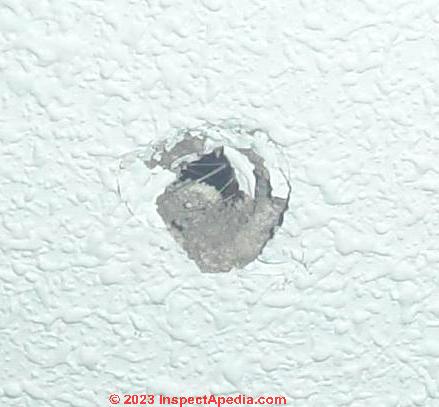 Building built in Spain in 2001.
Building built in Spain in 2001.
We recently had some rainwater damage to the plaster panels on the ceiling of the hallway of the house, which affected their joints areas and a small hole where a gray material is seen (picture 1 ).
The origin of the filtration was resolved. Insurance painted the surface, so the hole is no longer seen.
After this I obtained a sample of an edge of the plaster panels which was negative for asbestos, but did not have the gray material that is seen in the picture (it was the entire white sample).
The air conditioner return circulates through the false roof above these plaster plates.
I worry that the material seen in the hole, in case of containing asbestos, may be releasing fibers that circulate through the air conditioning throughout the house. Or when replacing the hall lights.
Any idea what it might be the gray material in the hole in the picture and any filament showing behind it? It doesn't look like asbestos material to me, but I would like a second opinion.
Thanks for your opinion!
(sorry about the grammar, I used google translate)
On 2024-01-09 by InspectApedia DF (mod) - rainwater damage to the plaster panels on the ceiling
@Jesús Vicente,
No se preocupas sober la idoma que usamos. Aqui a InspectApedia Hablamos espqan~ol tambien, pero no perfactamente. (Ahorita le escribo de mi oficina en Mexico.) O podemos usar Google Translate (con poco cuidado)
Creo que el material es gypsum - plaster - "drywall" - el pequen~o dano que veo es en local de un clave - in ingles decimos un "drywall nail pop" / pop de clave para paneles de yeso
Eso puede pasar si hay movimiento en la structura sobre el techo - in mi opinion no hay riesgo significante del polvo ni asbestos de dan~o tan pequeno.
Pero si lo deseas, se puede usar un filtro de alta capacidad en su systema de aire.
And for our English speaking readers, we answered:
Don't worry about the grammar. Here at InspectApedia we speak Spanish too, but not perfectly. (Right now I am writing to you from my office in Mexico.) Or we can use Google Translate (with a little care).
I think the material is gypsum - plaster - "drywall" - the small damage I see is from a nail pop - in English we say a "drywall nail pop" / nail pop for drywall.
That can happen if there is movement in the structure above the roof - in my opinion there is no significant risk from dust or asbestos from such minor damage.
But if you wish, you can use a high capacity filter in your air system.On 2024-01-10 by Jesús Vicente
@InspectApedia DF,
Thank you so much. I appreciate his opinion. I'm not worried at all about dust in general, I'm only worried if the material could have asbestos.
Greetings from Spain!!On 2024-01-10 by InspectApedia DF (mod)
@Jesús Vicente,
Gracias.
Hemos trabajado duro en este material durante décadas, por lo que estamos realmente agradecidos cuando un lector lo encuentra útil y digno de confianza.
También agradecemos sus fotos, preguntas, críticas o sugerencias.On 2024-01-11 by InspectApedia Publisher - sampling the drywall material itself can miss asbestos contained in the joint compound
@Jesús Vicente,
It's true that sampling drywall for asbestos is tricky because sampling the drywall material itself can miss asbestos contained in the joint compound used to cover joints and nails or screws.
However we've already stated our opinion about the level of risk, individual nail pop.
Estamos de acuerdo.On 2024-01-11 by InspectApedia Publisher
@Jesús Vicente,
Es cierto que tomar muestras de paneles de yeso en busca de asbesto es complicado porque el muestreo del material del panel de yeso en sí puede pasar por alto el asbesto contenido en el compuesto para juntas utilizado para cubrir juntas y clavos o tornillos.
Sin embargo, ya hemos comenzado nuestra opinión sobre el nivel de riesgo de estallido de los clavos individual.
On 2024-01-11 by InspectApedia Publisher - Spain didn't prohibit asbestos used in all forms until 2002 i
@Jesús Vicente,
Since Spain didn't prohibit asbestos used in all forms until 2002 it's possible, though unlikely, that you are 2001 drywall contains asbestos. However in my opinion the hazard of asbestos exposure from the tiny bit of dust that might fall from a nail pop is infinitesimal.
When you see damage like that simply damp wipe or HEPA vac the area and repair the damaged spot or if that's not convenient simply put a bit of tape over it as a short-term cover.
I suspect that the worry is probably a greater health hazard than the asbestos for extremely small points of damage such as this one.On 2024-01-11 by Jesús Vicente - in Spain, chrysotile asbestos in all its applications was prohibited in 2002
@InspectApedia Publisher,
Thanks again.
Indeed, in Spain chrysotile asbestos in all its applications was prohibited in 2002 (the other varieties had already been prohibited years before).
A sample from the side of those drywall panels was negative, but curiously it did not contain that gray material, since the entire sample was white.
The outside of the panel is already painted. The internal part, where the return conditioned air circulates, is difficult to access, but if, as you say, the risk is negligible even if it contained asbestos, perhaps the most sensible thing is to let it be and forget about the matter...
You are probably right that worry is more dangerous than dubious exposure.
Greetings and congratulations on your page!
On 2023-12-19 by Zach - Identify this black and gray fibrous insulation?
I live in Eugene, OR and own a home built in 1981. There is a little bit of exposed insulation in our bathroom that I was hoping you could identify and allay fears that it is asbestos or anything else dangerous. Thanks so much for your input.
On 2023-12-19 by InspectApedia-911 (mod)
@Zach,
What I see in your photo is either fiberglass or mineral wool insulation.
On 2022-09-30 by Sheila - how do I add insulation atop vermiculite?
More of a question than a comment. I live in Canton, Ohio and own a home built in 1942. The attic has tiny stone like vermiculite as seen in many photos already posted on this site.
My question is can you safely lay the roll out fiberglass type insulation over top of the vermiculite? Or have blown in put in? I've even considered laying plywood sheets across the attic beams and then putting insulation in top.
There is very little insulation in the attic and insulation in needed badly for both during the winter and summer months. Appreciate your insight, thank you.
On 2022-09-30 by InspectApedia-911 (mod) - vermiculite insulation can be safely covered over and left in place
@Sheila,
Yes, vermiculite insulation can be safely covered over and left in place. However if you are ever doing work on the building such as cutting a hole in ceiling or disturbing the insulation, it might be worth having a sample tested for asbestos.And I would not use blown in insulation because the blowing itself is going to disturb it. But laying insulation batts atop what's there, especially unfaced batts, should be fine.
On 2022-07-02 by Itsnotsafetoswimtoday000@gmail.com - identify this gray insulation
What does this look like to you...
On 2022-07-03 by InspectApedia-911 (mod)
@Itsnotsafetoswimtoday000,
Mineral wool
On 2022-03-13 by cory smith - identify this hard brown particulate insulation
Found a small hard dark brown particles in the attic for insulation. Never seen it before (15 Years) Looks like mice feces but is 4 inches or more thick.
On 2022-03-13 by Inspectapedia Com Moderator (mod) - brown granular insulation particles: Vermiculite?
@cory smith,
Try comparing your insulation to our Vermiculite photos - you'll find the link to our article on VERMICULITE INSULATION in the page above
On 2022-02-26 by Edward B. - confirm that this is mineral wool insulation?
Not exactly sure what kind of insulation this....it appears to look like mineral wool. Looking for verification.
On 2022-02-26 by Inspectapedia Com Moderator (mod)
@Edward B.,
Looks like mineral wool.
See the mineral wool photos at
INSULATION IDENTIFICATION GUIDE
https://inspectapedia.com/insulation/Insulation-Identification-Guide.php
On 2021-12-13 by Chris - identify this gray insulation
@Insulation Type, photo of the insulation in the floor.
Hello, I am trying to determine what type of insulation this is. I have an older house, built in 1906 with cedar siding. I can see 1-2" holes plugged every 6-12" going all the way around the house and up to the 3rd floor.
This insulation is in the walls and between the floors. I believe that its old newspaper, as I can see the print on some of the bits. Hoping you can confirm? Mainly want to make sure its nothing dangerous. Also, curious as to how long this remains effective? It's well-packed in the walls...
I have a home built in 1906 that has a blown-in insulation in the walls. I can see 1-2" holes on the exterior every 6-12" wrapping around the house all the way up to the 3rd floor. I think it's old newspaper, as I can make out letters on a few bits of the insulation.
I obviously want to make sure that it's not asbestos or somethign dangerous. I've attached a few photos for you to look at. If nothing dangerous, wondering how old this stuff is and how long it will last? Really appreciate the feedback...
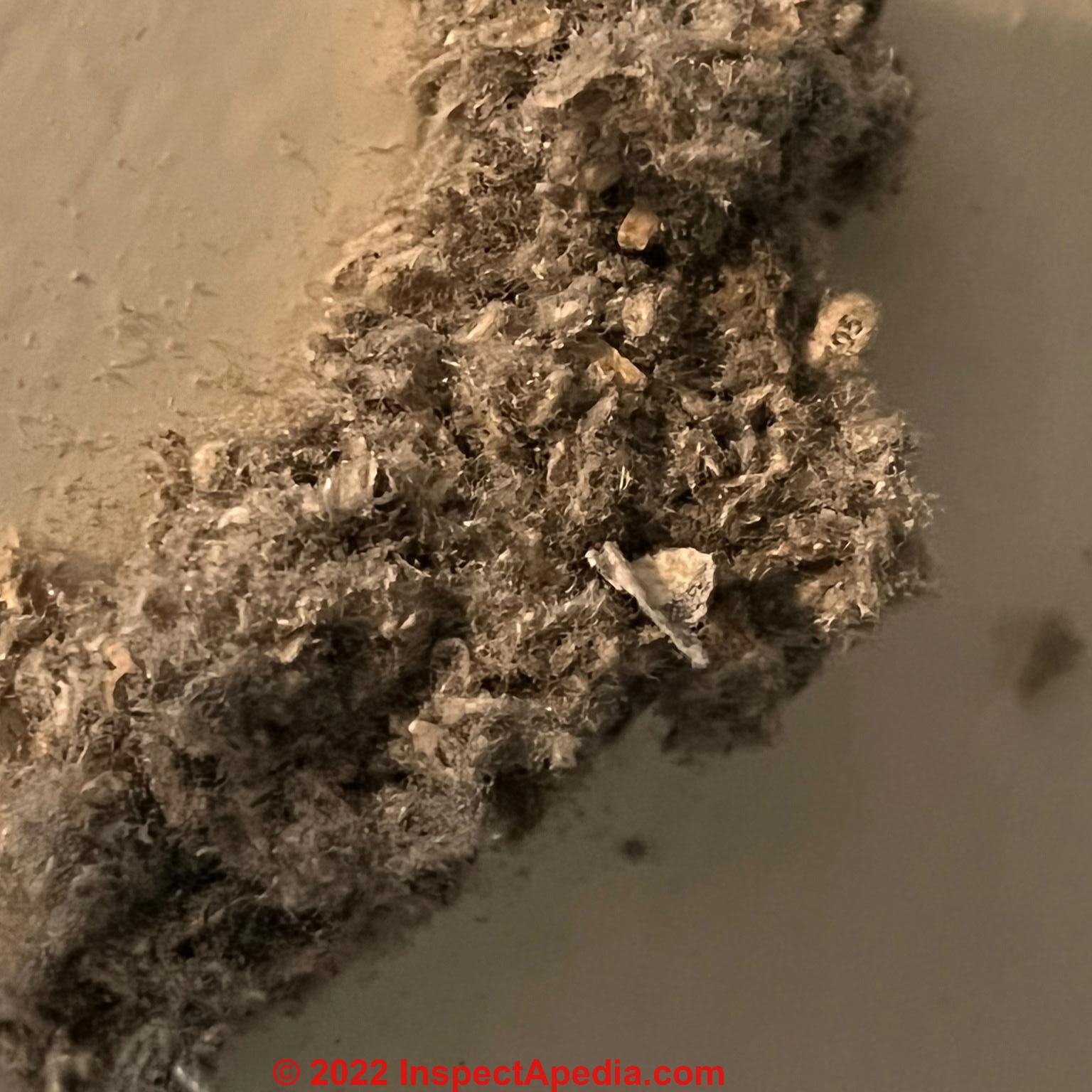
On 2021-12-13 by Inspectapedia Com Moderator (mod) - photos of cellulose insulation - notice the newspaper fragments!
@Chris, @Insulation Type,
Cellulose, probably blown-in
Please see INSULATION IDENTIFICATION GUIDE inspectapedia.com/insulation/Insulation-Identification-Guide.phpfor help identifying your specific insulating material.
When we see printing of letters and numbers on small bits of newspaper like material it's a good guess we're seeing cellulose insulation -
On 2021-09-01 by markvansomething
Just wondering about the insulation that is exposed in our bathroom around the skylight. By looking at it, can we be sure that it does not contain asbestos?
The house was built in 1980 in Australia.
On 2021-09-01 by inspectapedia.com.moderator (mod) - oakum insulation under metal roof at skylight?
@markvansomething,
Both moderators agree that your photo looks like a plant-based insulating material such as oakum or something similar.
Two of our articles describe asbestos insulation; please take a look at
ASBESTOS BUILDING INSULATION - forms, types, locations of asbestos used as building insulation
https://inspectapedia.com/hazmat/Asbestos-Building-Insulation.php
and
ASBESTOS INSULATION https://inspectapedia.com/hazmat/Asbestos_Insulation.php where more history and examples are discussed
We could also be seeing the edge of rooftop fiberboard or similar insulation installed in boards or sheets - I can't say from just the edge we see in your photo.
Below is an example of Oakum insulation. It's a plant fibre that is impregnated with a resin that expands when wet - used for centuries as a caulking on boards and on some buildings.
The example of oakum shown above is sold in Australia by https://shop.classic-boat-supplies.com.au/
On 2021-06-27 by Robert - should I replace insulation installed with its kraft facing in the wrong position? It's a wet area.
I have an old damp basement. The ceiling batten insulation was put in the wrong way (face side facing out) and I plan to remove it. After checking the joist areas for mold etc. would board insulation be a better choice for moisture remediation? (I also plan to address the wet issue at a later date)
On 2021-06-27 by friedmandaniel911
@Robert,
I agree in that I like closed cell foam insulation products in areas that might be exposed to moisture.Watch out: Of course most important is to find and address moisture sources.
On 2021-06-28 by Robert
@InspectApedia-911, Thank you Dan - you inspected my home in '96 and I appreciate your continued work in the field!
On 2021-06-28 by inspectapedia.com.moderator (mod)
@Robert,
My goodness - and we're both still kicking around. Thanks for the nice words.
It's not uncommon to find "wrong-way" insulation in a basement as the installer figured he was putting the barrier towards the "wet" side;
We also find a vapor barrier sandwich installation from time to time: barriers on both sides.
The trouble is water gets in to the sandwich over the life of the building but it has trouble getting out: hence rot, mold, etc.
Best:
1. fix the moisture before you re-insulate
2. consider closed cell foam spray insulation
On 2021-06-01 by Dominic - what is this hard gray insulation on our wall?
Hi there, I wonder if you could please help identify the exposed materials in this wall.
Worried it could be asbestos, but wondering if it might just be plaster (someone mentioned Lime Plaster). The building is late Victorian (1890's) and then was extended in 1920's in the UK. This is under a baseboard in an internal wall. Cheers! :)
On 2021-06-01 by mak.church (mod) - Plaster & Wood Lath in a U.K. 1920s home
@Dominic,
That's normal plaster and wood lath; No insulation is visible in the photo;
Plaster is not normally an asbestos material, but you can find some exceptions. The easiest way to find relevant information is to use the on-page search box to find our related articles such as:
ASBESTOS PHOTO GUIDE to MATERIALS
Mary
It would be extremely odd for an attic insulation to show up in your saliva. You need to discuss your concerns with your doctor.
**IF** the installers made a dusty mess and tracked fiberglass dust in the occupied space of your home, you could certainly have that space cleaned: damp wiping and HEPA vacuuming would be sufficient.
Never try to get your home down to zero fiberglass fragments. First, because low and normal levels of such fibers are harmless and second because you can't get rid of every dust particle or fibre in a building. Trying to do so is pouring money uselessly down the drain.
In fact testing indoor dust I find a few fiberglass fibers among indoor dust particles (which is normal) in just about every building and occupied space.
On 2021-01-19 by help identify
What is this insulation? and is it safe to breathe?
On 2021-01-20 by mod)
Help
That looks like fiberglass insulation wrapped around an HVAC ducty; [though a better photo could help us be certain it' snot a spray foam product)If you are not disturbing it there will be negligible levels of airborne particles at all and not harmful levels from such as small and undamaged source.
There's no maintenance required if it's not falling out or leaking air.
On 2021-01-20 by (mod)
Concerned:
Loose or falling fiberglass insulation may indeed need to be cleaned-up and such areas damp-wiped and/or HEPA vacuumed as part of the insulation repair.
...
Continue reading at INSULATION IDENTIFICATION GUIDE or select a topic from the closely-related articles below, or see the complete ARTICLE INDEX.
Or see INSULATION IDENTIFICATION FAQs - questions & answers posted originally at this page
Or see these
Recommended Articles
- ASBESTOS IDENTIFICATION - How to find and recognize asbestos in Buildings - visual inspection methods, list of common asbestos-containing materials
- CARBON NANOTUBE MATERIALS
- FIBER & HAIR IDENTIFICATION
- FIBERGLASS HAZARDS - Indoor Air Quality Investigations: Health Concerns About Airborne Fiberglass: Fiberglass in Indoor Air from HVAC ducts, and Building Insulation
- HEAT LOSS R U & K VALUE CALCULATION
- HUMIDITY CONTROL & TARGETS INDOORS - What indoor humidity should we maintain in order to avoid a mold problem?
- INSULATION AIR & HEAT LEAKS
- INSULATION CHOICES & PROPERTIES
- INSULATION IDENTIFICATION GUIDE
- INSULATION INSPECTION & IMPROVEMENT - home
- INSULATION LOCATION - WHERE TO PUT IT
- INSULATION R-VALUES & PROPERTIES - R-values & U Values of various materials
- RADIANT BARRIERS
- REFLECTIVE INSULATION
Suggested citation for this web page
INSULATION INSPECTION & IMPROVEMENT at InspectApedia.com - online encyclopedia of building & environmental inspection, testing, diagnosis, repair, & problem prevention advice.
Or see this
INDEX to RELATED ARTICLES: ARTICLE INDEX to BUILDING INSULATION
Or use the SEARCH BOX found below to Ask a Question or Search InspectApedia
Ask a Question or Search InspectApedia
Try the search box just below, or if you prefer, post a question or comment in the Comments box below and we will respond promptly.
Search the InspectApedia website
Note: appearance of your Comment below may be delayed: if your comment contains an image, photograph, web link, or text that looks to the software as if it might be a web link, your posting will appear after it has been approved by a moderator. Apologies for the delay.
Only one image can be added per comment but you can post as many comments, and therefore images, as you like.
You will not receive a notification when a response to your question has been posted.
Please bookmark this page to make it easy for you to check back for our response.
IF above you see "Comment Form is loading comments..." then COMMENT BOX - countable.ca / bawkbox.com IS NOT WORKING.
In any case you are welcome to send an email directly to us at InspectApedia.com at editor@inspectApedia.com
We'll reply to you directly. Please help us help you by noting, in your email, the URL of the InspectApedia page where you wanted to comment.
Citations & References
In addition to any citations in the article above, a full list is available on request.
- Asbestos Identification, [link to purchase this text] Walter C.McCrone, McCrone Research Institute, Chicago, IL.1987 ISBN 0-904962-11-3. Dr. McCrone literally "wrote the book" on asbestos identification procedures which formed the basis for current work by asbestos identification laboratories.
- Stanton, .F., et al., National Bureau of Standards Special Publication 506: 143-151
- Pott, F., Staub-Reinhalf Luft 38, 486-490 (1978) cited by McCrone
- Brick Nogging, Historical Investigation and Contemporary Repair, [Web article] Construction Specifier, April 2006. Historical use of brick in timber-framed buildings, drawing on the investigations of the Kent Tavern in Calais, VT. "Brick nogging is a European method of construction which was brought to the new world in the early-nineteenth century. It was a common construction method that employed masonry as infill between the vertical uprights of wood framing." -- quoting the web article review.
- Insulate & Weatherize (Taunton's Build Like a Pro), [link to purchase this document] Bruce Harley. Review quoted:
An engineer who trains builders in energy-efficient construction, Harley offers a wealth of information that will allow readers to improve their home's efficiency, saving both money and natural resources. After an introductory section that explains the underlying principles of heat transfer, insulation, and air quality, Harley demonstrates basics such as weather-stripping and moves forward through advanced projects including insulation and major upgrades. Short "Pro Tips" as well as sections labeled "Trade Secrets," "What Can Go Wrong," and "In Detail" provide a great deal of helpful information. Increasing energy efficiency is one of the easiest ways for homeowners to save money - Principles of Heating, Ventilating, And Air Conditioning [link to purchase this document] A textbook with Design Data Based on 2005 ASHRAE Handbook - Fundamentals, Harry J., Jr. Sauer, Ronald H. Howell, William J. Coad. Quoting
... textbook for college level HVAC courses or independent study and review, especially when combined with the 1997 ASHRAE Fundamentals Handbook. Contains the most current ASHRAE procedures and definitive, yet easy to understand, treatment of building HVAC systems -- from basic principles through design and operation. Dual units of measurement. - Super-Insulated Retrofit Book: A Homeowner's Guide to Energy-Efficient Renovation, [link to purchase this document] Robert Argue
- The super-insulated retrofit book: A homeowner's guide to energy-efficient renovation [link to purchase this document] (Sun builders series), Brian Marshall
- Understanding Ventilation: How to Design, Select, and Install Residential Ventilation Systems, [link to purchase this document] John Bower, Quoting:
Understanding Ventilation is the only book that covers all aspects of exchanging the air in houses: infiltration, equipment selection, design, heat-recovery ventilators, sizing, costs, controls, whole-house filters, distribution, and possible problems that a ventilation system can cause--all in easy-to-understand language. - Weaver: Beaver Board and Upson Board: Beaver Board and Upson Board: History and Conservation of Early Wallboard, Shelby Weaver, APT Bulletin, Vol. 28, No. 2/3 (1997), pp. 71-78, Association for Preservation Technology International (APT), [link to purchase this document] available online at JSTOR.
- In addition to citations & references found in this article, see the research citations given at the end of the related articles found at our suggested
CONTINUE READING or RECOMMENDED ARTICLES.
- Carson, Dunlop & Associates Ltd., 120 Carlton Street Suite 407, Toronto ON M5A 4K2. Tel: (416) 964-9415 1-800-268-7070 Email: info@carsondunlop.com. Alan Carson is a past president of ASHI, the American Society of Home Inspectors.
Thanks to Alan Carson and Bob Dunlop, for permission for InspectAPedia to use text excerpts from The HOME REFERENCE BOOK - the Encyclopedia of Homes and to use illustrations from The ILLUSTRATED HOME .
Carson Dunlop Associates provides extensive home inspection education and report writing material. In gratitude we provide links to tsome Carson Dunlop Associates products and services.


